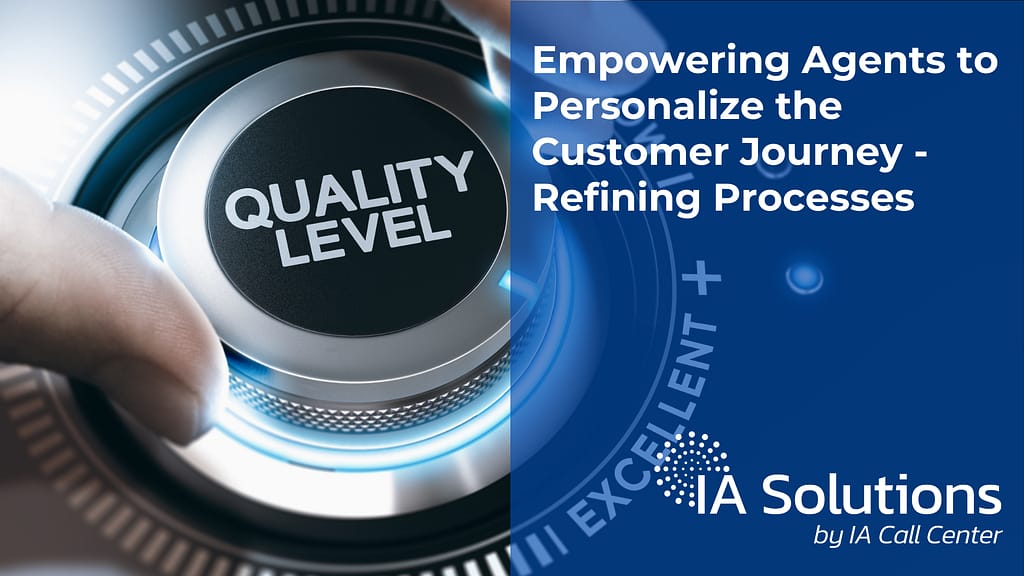Empowering Agents to Personalize the Customer Journey – Refining Processes
Rather listen to the audio for this post instead? Click the play button below to hear it now.
(Note – This is the eighth post in our 10-part series, “Empowering Agents to Personalize the Customer Journey.” If you missed the last one, “Evaluating Progress,” please click here to view it now. We will release new posts for this series every week. Therefore, please be sure to sign up to follow our blog to receive updates when we post new articles.)
Introduction
As more businesses adopt an omnichannel approach to customer service, the challenge of providing a personalized customer journey across channels becomes more complex. A key component in overcoming this challenge is refining processes to empower agents with the tools and resources they need to provide a personalized experience.
In this article, we’ll explore the critical components of refining processes, including customer data analysis, comprehensive training and resources, streamlined processes, customer feedback, and the role of AI and automation. Additionally, we will discuss the impact refining processes have on customers and agents, as well as provide some specific examples of how you might go about refining processes for your omnichannel implementation.
Analyzing Customer Data: A Critical Component of Refining Processes
Analyzing customer data is a critical component of refining processes to provide personalized customer journeys. By analyzing customer behavior and preferences, your business can identify opportunities to improve customer journeys and provide more targeted offers and recommendations.
Your business can do this by collecting customer data through a variety of channels, including website analytics, social media monitoring, and customer surveys. Once collected, your company can use data analytics tools to identify trends and patterns in customer behavior, enabling you to make data-driven decisions about how to improve your omnichannel implementation.

Providing Comprehensive Training and Resources to Empower Agents
Empowering your agents to provide a personalized customer journey requires comprehensive training and resources. Therefore, you must train your agents to use all communication channels and provide consistent experiences across all channels. You must also equip agents with customer data and knowledge of your business’s products and services.
Providing your agents with the training and resources needed to do their jobs effectively not only empowers them to provide a personalized customer journey but also increases their job satisfaction and retention.
Streamlining Processes to Improve the Customer Journey
Reducing the number of steps necessary to complete processes is a fundamental piece of personalizing the customer journey. Therefore, by lowering the number of steps and interactions required to complete a customer’s request, your team can improve the customer journey and decrease customer effort.
For instance, your business can introduce self-service options for routine inquiries or automate workflows to raise accuracy and efficiency. Streamlining processes not only enhances the customer journey but also boosts the productivity of your agents, allowing them to concentrate on more complex problems.
Implementing Customer Feedback to Refine Processes
Customer feedback is a powerful resource for refining processes to deliver a personalized customer journey. Gathering customer feedback and using it to improve your omnichannel approach can help your business identify customer issues during their journey with your brand. Therefore, use tools such as email surveys, social media observations, and focus groups to gather customer opinions and feedback.
After obtaining customer feedback, your business can use the data to improve your omnichannel approach and procedures.
The Role of AI and Automation in Refining Processes
Making use of AI and automation can be vital in streamlining processes and providing a tailored customer journey. AI-enabled chatbots, for example, can handle routine customer inquiries, allowing agents to concentrate on more complex issues. Automation of processes can increase productivity and precision, lowering the prospect of mistakes and slowdowns. However, it is essential to attain a balance between automation and the human touch, since many customers will still desire human connections in their interactions with your business.

The Importance of Real-Time Data in Refining Processes
Obtaining data in real-time is vital for streamlining processes and providing customers with a journey tailored to their individual needs. Tracking customer behavior and preferences in real-time allows your business to change omnichannel strategies without delay. Real-time data can also enable your business to provide personalized offers and recommendations based on customers’ current situations, such as their locations or recent purchase histories.
The Importance of Reviewing KPIs and Metrics
Customer sentiment is the collective opinion and attitude of customers towards your brand or company. We can track it using KPIs and metrics, such as customer satisfaction ratings, Net Promoter Score (NPS), and customer reviews (among others.)
These metrics can give you a glimpse into how customers perceive your company’s products, services, and overall experience. Examining the following metrics can help your business recognize areas that need work and make decisions backed up by data to strengthen your omnichannel approach. These are some KPIs and metrics to consider:
Customer Satisfaction Score (CSAT)
The CSAT is a measure of how satisfied customers are with the service they receive. This metric requires a survey question that inquires about a customer’s satisfaction with a given experience or interaction. Understanding customer satisfaction ratings throughout the customer journey will provide you with a clearer picture of how customers feel about your service.
A study by SuperOffice shows that the general CSAT rating across all industries is 8.6 (or 86%), suggesting that customers are relatively pleased with their service. However, the survey showed the average CSAT score of virtual sellers was lower, at 83%. This indicates that online vendors may need to center more on delivering a personalized customer journey to increase their CSAT ratings.
Net Promoter Score (NPS)
The NPS is a way to calculate how committed customers are to your product or service and the chance of them recommending it to others. To get your customers’ Net Promoter Score, you use a one-question survey asking them to rate their willingness to recommend your product or service from 0 to 10. Reviewing NPS scores from different touchpoints with customers can give you a better understanding of customer loyalty and advocacy.
According to Salesforce, the average NPS score for all industries is 3.2. This implies that there are many opportunities to improve customer loyalty and support throughout all industries. Therefore, maximizing your NPS score should be a top concern, as word-of-mouth referrals are still the most influential form of marketing, even in the digital era.
First Contact Resolution (FCR)
The FCR metric gauges the percentage of customer questions addressed during the initial contact with your customer service team. A high FCR rate demonstrates that agents are resolving customer issues the first time your customers reach out, which also increases satisfaction.
According to research from CallMiner, most industries have an FCR rate of around 70%. This points to the need for better resolution of customer inquiries upon initial contact.
Average Handle Time (AHT)
AHT is a metric that measures the average time it takes an agent to manage a customer’s question or interaction. When the Average Handling Time is low, it indicates that agents are able to answer customer inquiries efficiently, resulting in higher customer satisfaction.
Research conducted by CallCentreHelper found the typical AHT across industries is approximately 6 minutes. This points to the possibility of reducing AHT to increase agent effectiveness and customer satisfaction.
Customer Effort Score (CES)
The CES metric measures how easy it is for a customer to use a company, product, or service. Businesses usually determine the experience using a survey that requests customers to rate the simplicity of their experience from 1 to 5. Examining the CES scores from different touchpoints will give you an indication of how much effort customers are putting into connecting with your business.
Contact-center industry studies suggest that the typical CES score across industries is roughly 4 out of 5. This implies that reducing customer effort could be beneficial for the customer experience.

How Metrics Impact Customer Sentiment
Pinpointing how metrics shape customer emotion is a necessary step in refining processes for an omnichannel implementation. It’s necessary to track KPIs and metrics, yet it’s just as important to understand how they influence customer sentiment. Consider these key points when analyzing how metrics influence customer sentiment:
Identify the Metrics That Matter
Not all metrics have the same significance. Tracking a range of different metrics is important. However, it is even more important to recognize the ones that have the most effect on customer sentiment.
By measuring customer satisfaction scores (CSAT), your business can gain an understanding of customer happiness. Furthermore, by breaking down this metric through touchpoints, you can identify which areas need to be improved. Likewise, gauging customer loyalty through Net Promoter Score (NPS) can assist your business in understanding if customers will recommend your products or services to others.
Analyze Trends Over Time
Metrics can paint a picture of the customer experience. By observing patterns over time, your business can identify places where sentiment is improving or diminishing. If the CSAT score for a particular touchpoint has been slipping, it may be a good sign that it needs improvement.
Consider the Context
Statistics don’t tell the whole story, though. It’s also important to consider the context in which they were collected. For instance, a low CSAT score for a certain touchpoint could be the result of a single incident rather than a recurring problem. Therefore, by considering context, your business can make more knowledgeable decisions on how to upgrade customer experiences.
Align Metrics With Business Goals
The metrics you use should always be consistent with your business objectives. To illustrate, if the purpose of refining your omnichannel processes is to increase customer loyalty, measuring NPS may be more advantageous than measuring CSAT. Hence, ensuring the metrics you use align with your business objectives will help your company keep track of data that leads to satisfied customers.
Use Metrics to Drive Action
Metrics are only meaningful when used to prompt action. Therefore, after analyzing metrics and recognizing patterns, your business should use this data to take action. An illustration: if the CSAT score for a particular touchpoint is low, locate the fundamental cause of the problem and take steps to better the experience.
How Metrics Impact Agents
Metrics not only impact customer sentiment; they affect agent sentiment as well. Your agents are the first point of contact for customers. It is their job to ensure a positive customer experience and reach your business objectives. Bearing this in mind, here are some key points to be aware of when examining how metrics influence agent sentiment:
Choose Metrics That are Fair and Accurate
Metrics should be fair and accurate and should not put undue pressure on your agents. Furthermore, agents should be able to meet their goals without sacrificing the quality of the customer experience. However, if an agent’s performance is only judged based on how quickly they handle a customer interaction, they may feel rushed to finish the conversation without adequately addressing the customer’s needs.
Provide Regular Feedback and Coaching
Regular support and direction are necessary to make sure agents stay encouraged and inspired. Agents should have their work evaluated regularly, which should include both positive reinforcement and constructive criticism. Your feedback should be geared towards assisting your agents to develop their skills and achieve their objectives. Additionally, you should give agents opportunities to ask questions and offer their own strategies for boosting the customer experience during coaching sessions.

Use Metrics to Motivate and Empower Agents
Metrics can be a powerful tool for motivating and empowering agents. Therefore, agents should be given the opportunity to view their own performance data so they can track their progress and recognize areas they can improve. You should also offer agents opportunities to set their own goals and take ownership of their results.
Encourage Collaboration and Support
Collaboration and support are key to maintaining agent morale and motivation. Hence, your agents should feel that they are part of a team and that they have the support of their colleagues and managers. By collaborating, agents can learn from each other and find the best strategies for delivering a fantastic customer experience.
Grant your agents the autonomy and authority to independently make certain high-level decisions on their own. This will help your agents gain customers’ trust and provide better experiences.
Focus on Quality Over Quantity
Your business should not use metrics to focus solely on quantity. Instead, concentrate metrics more on quality. Encourage your agents to take the time they need to address customers’ needs thoroughly and to ensure that they satisfy customers with outcomes and experiences. Quality metrics, such as customer satisfaction scores and feedback, help ensure that agents are delivering the best customer service possible
Examples of How to Refine Processes for Your Omnichannel Implementation
- Carry out A/B Testing: A/B testing is the method of looking at two versions of a process or system to determine which one works better. By conducting A/B testing on different parts of your omnichannel implementation, such as messaging or user interface, your business can refine processes to better meet the needs of your customers.
- Incorporate Data Visualization: Data visualization is the use of diagrams, graphs, and other visual tools to assist businesses in comprehending their data more thoroughly. With the help of data visualization tools, your business can gain a clearer understanding of customer data, allowing you to identify areas for improvement.
- Focus On Key Performance Indicators (KPIs): KPIs are the metrics that businesses use to measure the success of their operations. If your business concentrates on important performance indicators like customer satisfaction, conversion rates, and average order value, you can adjust your omnichannel processes to better these metrics.
- Provide Feedback to Agents: By providing feedback to your agents on their performance, you can help them better understand their role in the omnichannel approach and how they can improve the customer journey. Through providing feedback on specific areas for improvement, your business can refine agent processes and empower them to provide a better customer experience.
- Leverage Customer Journey Mapping: Customer journey mapping is creating a visual representation of the customer journey, from initial contact to purchase and beyond. By utilizing customer journey mapping, your business can gain insight into the customer experience and pinpoint areas for improvement, like simplifying procedures or optimizing communication channels.
More Examples: Personalizing the Customer Journey – Refining Processes
- Conduct Root Cause Analysis: Root cause analysis is identifying the underlying cause of an issue or problem. Your business can use root cause analysis to determine why your omnichannel approach is not meeting expectations, which will allow you to make refinements to processes and improve the customer experience.
- Automate Process and Workflows: Automation is the application of technology to replace manual processes. Automating mundane or labor-intensive tasks can help your business streamline its procedures and free up agents and team members to focus on other areas that need attention.
- Track Industry Trends: Keeping up with industry trends and best practices can help businesses identify improvements for their omnichannel approach. By monitoring trends and introducing new ideas, your business can refine its procedures to outpace the competition and give customers a better experience.
- Employ Predictive Analytics: Predictive analytics is the approach of utilizing data, statistical models, and machine learning to recognize the probability of future results. You can use predictive analytics to spot potential issues or opportunities, which can help your company improve its processes to better handle those areas, resulting in an enhanced customer experience.
- Adopt Ongoing Improvement Strategies: Ongoing improvement strategies are approaches that center on continually bettering and developing current processes. Your company can use a continuous improvement process to assess the omnichannel approach, recognize areas that need improvement, and adjust processes to give customers more personalized journeys and experiences.

The Challenges of Refining Processes
When it comes to personalizing the customer journey, refining processes can be a challenging and time-consuming process. Therefore, your business must be prepared to invest in the necessary resources and technologies to make meaningful changes to your omnichannel approach.
Furthermore, overcoming the reluctance of your agents, other team members, and stakeholders to change can also be a roadblock to successful implementation.
Ultimately, it can be hard to gauge the success of refined processes, as it is often hard to link process changes to customer satisfaction metrics. However, if you persist in refining your processes regularly, you’ll eventually learn what works and what does not. Regardless, in the end, you will see some progress and development.
Summary
It is important to refine your omnichannel strategy to meet advancing and ever-changing needs of customers. Examining growth, tweaking procedures, and introducing changes in technology, operations, and personnel can create a consistent and uniform customer experience across all touchpoints.
Furthermore, employing data analytics to customize the customer experience can be beneficial, as well as training and equipping agents to provide a personalized experience. Finally, integrating channels to create a fluid experience can ensure customers the same degree of service no matter what touchpoint they use, and having the capability to monitor and respond in real-time can help with your omnichannel strategy.
Strengthening your omnichannel strategy leads to increased customer satisfaction, increased brand loyalty, more sales and revenue, and a competitive advantage.
The next post in our Empowering Agents to Personalize the Customer Journey series will look at how to actually change and improve your omnichannel implementation, after utilizing the steps in this article to refine your processes. Therefore, if you’re looking for information on how to improve your omnichannel services, check in with us a few days after this post.















